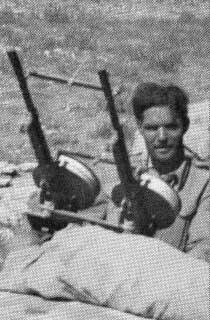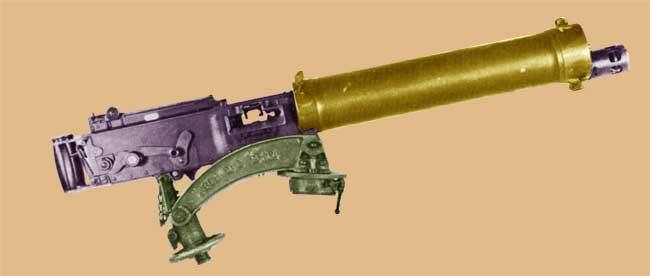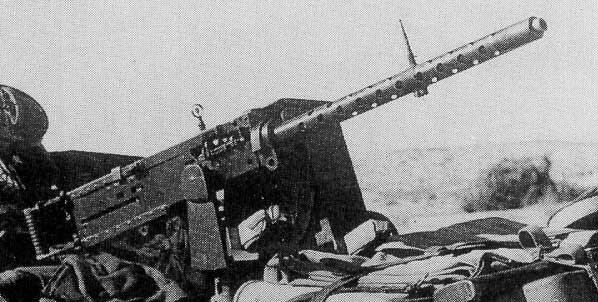The Lewis Gun

Obsolete before the WW2 even began, the Lewis Gun dates back to before World War I. Designed by US Army Colonel Isaac Newton Lewis, the gun was never officially adopted by the Americans but was quickly accepted by the British who used it extensively during World War I. The most striking feature of the Lewis Gun is the cooling jacket that wraps around and extends beyond the actual barrel of the gun.
While it was relatively heavy for one man to carry it was rugged, reliable, and accurate. It was often found mounted on vehicles during the first few years of the war and continued to be used as an anti-aircraft machine gun in the Royal Navy and with Home Guard units through out the war.
According to more than one source, The Lewis Gun was used by the LRDG, because it was more suited for their mission. It is never fully explained how but the assumption would be the higher rate of fire and the capacity of the pan magazines.
Specifications:
- Ammunition: .303 SAA Ball
- Action: Gas Operated
- Length: 50.5 Inches
- Weight, Unloaded: 26 lb
- Barrel: 26.25 inches
- Magazine: 47 or 97 round drum
- Cyclic Rate of Fire: 550 RPM
- Muzzle Velocity: 2450 FPS
Vickers GO (Vickers Gas Operated) -- The 'K' Gun

The Vickers Gas Operated or VGO (often referred to as Vickers K) is probably the machine gun most associated with the SAS because this small aircraft pattern machine gun was mounted on their jeeps
The VGO has a somewhat long and winding history. The VGO is a modified version of the Vickers Berthier or VB. While similar to the Bren gun in appearance and some aspects of function, the origins of the VB lay elsewhere. The VB was a license built copy of the French Berthier LMG. The French Berthier LMG was originally designed by General Adolphe V.P.M. Berthier. Its design predates World War I.
The Vickers Company of Great Britain obtained a license to build a copy of the Berthier machine gun in 1925. In 1927 Vickers submitted their version of the Berthier for machine gun trials. The light machine guns was officially designated Mk1 Light Machine Gun by Vickers but was commonly called the Vickers Berthier or VB.
The VB was Vickers entry in the early machine gun competition to replace the Lewis Gun. The VB functions in almost every respect the same way that the Bren does but failed to find followers in the British Army. The VB was adopted by the Indian Army as their standard LMG before the British adopted the Bren and continued to be manufactured in India throughout the War. There was one crucial difference between the Bren and VB. Due to the design of the breech block on the VB it's rate of fire could be adjusted to as much as 1,200 rounds per minute. It was quickly realized that a MG firing at such a rate would be ideal for anti-aircraft use and so the VB was modified for use in Aircrafts. When the VB was adopted as an observer's gun in aircraft it was known as he VGO.
The weapon was adopted because there were many of them not being used by the RAF in the ME. There was subsequently a tussle with them because the Ground Defense Officer decided they would be good for airfield defense
It is said that David Stirling settle on the VGO to arm his jeeps because it was a anti-aircraft gun and what better weapon to use on aircraft than an anti-aircraft gun. With the outbreak of the War it was quickly realized that aircraft speed had progressed so much that it was virtually impossible for an observer in a moving aircraft to engage another aircraft with the free swinging LMG.
Fortunately for Stirling's SAS and members of the LRDG, the VGO was quite effective as a jeep or truck mounted machine gun against stationary targets and even against strafing aircraft.
So why do so many people call the VGO, the Vickers K? That's simple. It is what Vickers, the company that produced the gun, called it commercially.
Specifications:
- Ammunition: .303 SAA Ball Length:
- Action: Gas Operated
- Weight, Unloaded: 20 lb
- Length:40 inches
- Barrel: 20 inches
- Magazine: 47 or 97 round drum
- Cyclic Rate of Fire: 700-950 RPM
- Muzzle Velocity: 2400 FPS

Guardsman Duncalfe mans a pair of Twin Ks mounted on an LRDG Jeep during the Barce Raid.
Vickers Machine Gun
(Sometimes called the Vickers Maxim)

The Vickers Machine Gun was virtually a lightened Maxim Gun built under license by Britain and throughout the Commonwealth.
It was the standard medium/heavy machine gun of the British army from before World War I and up to 1960. While most armies had adopted some kind of air cooled machine gun for their principle MG, the British continued to rely on the water cooled Vickers. Despite its weight it was unsurpassed in reliability. As long as the condenser was kept filled with water, the Vickers could be fired for an indefinite period of time.
What's more, the British soldiers held the Vickers in absolute awe, considering it better than any other MG ever made. With such un-dying devotion the Vickers was never considered obsolete and the British never thought twice of of developing a new machine gun to take its place.
Specifications:
- Ammunition: .303 SAA Ball
- Action: Recoil
- Length: 45.5 inches
- Weight, Unloaded: 33 lb (40 lb w/water)
- Barrel: 28.5 inches
- Magazine: 250 round canvas belt
- Cyclic Rate of Fire: 450 RPM
- Muzzle Velocity: 2440 FPS
Browning AN M2 .30 Machine Gun (.303 Mk II in British Service)
(Also called: Browning Air Pattern or Vickers Armstrong)

Developed by Browning after World War I and adopted by the United States Army in 1929, the AN M2 .30 caliber machine gun was an excellent weapon for its time. Initially chambered to fire the standard U. S. .30 '06 Cartridge (the thirty, aught six) when the machine gun was adopted by the Royal Air Force it was manufactured by Vickers Armstrong to fire the .303 rimmed cartridge (the British Standard) and its nomenclature changed to Mk II.
The machine gun was designed to fire hydraulically as a wing mounted gun but was also adopted as hand fired mount for use in bombers and reconnaissance aircraft. It was considered rugged, reliable, and accurate. It was only capable of full automatic fire.
One source claims the first Mk II to be used by the LRDG were salvaged from a shot down Hawker Hurricane. The wing mounted guns were fired using a solenoid. This meant the LRDG had to fabricate a new firing mechanism in order to use the guns. A steel tube was welded to a metal plate that in turn was hinged to the back of the gun. Pressure was applied to the solenoid by manipulating the steel plate. The tube was used to assist in applying pressure as well as aiming the machine gun.
Specifications for MK II:
- Caliber: .303 Rimmed*
- Action: Recoil
- Weight: 23 pounds
- Length: 39.8 inches
- barrel: 23.9 inches
- Rate of fire: 1140 RPM
- Muzzle Velocity: 2840 FPS.
* for models made for British service.
Browning AN M2 .50 Machine Gun
(Also called: Browning .50 Air Pattern, M2 Air Pattern.)

Developed as a replacement for the AN M2 .30 MG, the .50 caliber is virtually an identical copy only larger. Unlike the .30 version this model was not chambered for a specific British caliber but instead the British adopted the American 50 caliber round.
The machine gun became the standard wing armament for most U.S. fighter planes and was also used in American bombers for their numerous gun stations. Like its smaller brother, the weapon proved to be tough, reliable, and accurate. Again, some models were subcontracted and made by Vickers Armstrong. This is not the same gun as a Vickers 50, however. Unlike the smaller .303 version, the 50 seemed to only have spade grips added an not the metal butt-stock made from tubing.
The main differences between the AN M2 .50 and its cousin the M2 HB (heavy barrel) are:
- Faster rate of fire (the AN M2 is almost 300 RPM's faster)
- It weighs 17 pounds less
- Can only fire automatic (the M2 HB can fire single shots)
- no quick change barrel
This is not the same as the Vickers .50 but some sources seem to confuse the two machine guns.
Specifications:
- Caliber: .50 (U.S.)
- Action: recoil
- Weight: 61 pounds
- Length: 64 inches
- Barrel: 37 inches
- Rate of fire: 750-800
- Muzzle Velocity: 2900 FPS


An SAS Jeep mounting Browning AN M2 .50 machine gun
Mk V Vickers .50 Inch Machine Gun (Vickers 50)

(Mk. III Naval .5 Vickers)
First entering service in 1932, the Vickers .50 machine gun was designed primarily as an anti-aircraft weapon and was used extensively in this role.
The Mk III (shown above) was the Royal Navy version. The Mk V (the final improved version) approved in 1935 and used in armored fighting vehicles. About 1,000 were made. The most noticeable difference between the .303 Vickers and the .5 is the overall size, the larger flash hider on the end of the barrel, and the fluted water jacket. and the pistol grip. (All. .5 vickers have the fluted jacket while only some .303 Vickers have them.)
The Vickers used a shorter, less powerful round than the Browning M2 series and the rounds were not interchangeable.
Vickers .5 MGs were primarily mounted in early British AFV, especially the light tanks. It was also mounted in Bren Bun carriers. Unlike its smaller cousin, the .5 in. used a pistol grip instead of the dual spade grips. The pistol grip was located under the gun's receiver. Pictures of the AFV .5 in. Vickers can be found in Brendan O' Carroll's book, Barce Raid.
Specifications Mk. V Vickers
- Caliber: .5V/580 (50 Cal)
- Action: Recoil
- Weight: 63 pounds (water jacket empty)
- Barrel: 31 inches
- Length: 52.4 inches
- Rate of fire: 500-600
- Muzzle Velocity: 2,540 FPS

Sketch of a Vickers .5inch.
Browning M2HB
The least used heavy machine gun in the LRDG was the Browning M2HB. The HB stands for Heavy Barrel. Originally designed near the end of WWI the Browning .50 was basically an enlarged version of his .30 M1917 mg. Originally the gun water cooled and designated M1921. By 1936 the designation was changed to M2. Two variants were made for the gun around that time. The AN-M2, described above was the first air-cooled version which was acceptable when used in aircraft because the moving air and lower temperatures kept the barrels from over heating. Unfortunately this was not the case with the ground mounted versions. When fired from a ground mount, the AN-M2 had a tendency to overheat and if prolonged fired continued, the barrel could melt and warp. The solution was to make a heavier barrel that could be changed more easily that the barrel of the AN-M2. This became the M2HB.
While the Vickers .5in Mk. V and the ANM2 were the most commonly used fifty caliber machine guns used by the LRDG, by 1943 some M2HBs were making there way onto the trucks. A possible advantage of the M2HB was its slower rate of fire (compared to the AN-M2) allowing it to conserve ammunition. One unique aspect of the M2HB is its ability to fire single shots. No other heavy machine gun used by the Western Allies had this ability.
Specification:
- Weight: 83 pounds
- Length: 65 in (1,650 mm) ()
- Barrel length: 44 in (1,140 mm)
- Cartridge: .50
- Operation: Recoil
- Action:: Automatic, single shot
- Rate of fire 450-550 rpm
- Muzzle velocity 3,050 fps
- Effective range 1,800 m
- Feed system disintegrating belt-fed

Browning M2HB
Read more:
